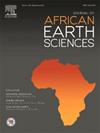First report of late Messinian Lago-Mare micropaleontological assemblage in northeastern Algeria (Beni Fouda Basin)
IF 2.2
4区 地球科学
Q2 GEOSCIENCES, MULTIDISCIPLINARY
引用次数: 0
Abstract
This study presents the first detailed micropaleontological investigation of Late Messinian Lago-Mare facies in the Beni Fouda Basin (Northeastern Algeria). Analyzing 20 samples from four stratigraphic sections (KAL, KAU, KAM, DH), our findings reveal an oligotypic micropaleontological assemblage comprising six ostracod taxa (five genera) alongside dominant charophytes, with Sphaerochara miocenica being the only species formally identified. The assemblage, characterized by euryhaline Cyprideis species and freshwater taxa like Ilyocypris gibba and Candona angulata, indicates transitional lagoonal environments with significant fluvial influence. Here, we report the first documented occurrence of the genus Zonocypris in North Africa, contributing new data to our understanding of its biogeographic distribution.
A major contribution of this study is the stratigraphic positioning of Lago-Mare deposits above the Turolian Amama 2 vertebrate level, which significantly reduces the estimated hiatus between the Turolian and Pliocene in northeastern Algeria. This finding refines the regional stratigraphic framework and highlights regional variations in Lago-Mare environments. Unlike the Chelif Basin, the Beni Fouda Basin is characterized by a persistent freshwater influence, the absence of marine planktonic microfossils, and a lack of evidence for the Messinian Erosional Surface, emphasizing the influence of local factors on Messinian paleoenvironments. Furthermore, the presence of Paratethyan-affinity taxa supports the hypothesis that the paleo-Sicily Channel allowed faunal exchange between the Eastern and Western Mediterranean during the Late Messinian. This first report of Lago-Mare species in northeastern Algeria provides significant new insights into the stratigraphy and the Messinian-Pliocene transition in the region.
阿尔及利亚东北部(贝尼富达盆地)晚墨西尼亚Lago-Mare微体古生物组合首次报道
本文首次对阿尔及利亚东北部贝尼富达盆地晚墨西尼亚期Lago-Mare相进行了详细的微体古生物研究。分析了来自4个地层剖面(KAL, KAU, KAM, DH)的20个样品,我们的发现揭示了一个由6个介形虫分类群(5属)和优势蕨类组成的寡型微古生物组合,其中Sphaerochara miocenica是唯一正式确定的物种。该组合以广盐塞浦路斯物种和淡水类群如长臂猿和角鹬为特征,表明河流影响较大的过渡性泻湖环境。在这里,我们报告了在北非首次记录到的佐盖普斯属,为我们了解其生物地理分布提供了新的数据。本研究的一个主要贡献是将Lago-Mare沉积物的地层定位在turrolian Amama 2脊椎动物水平之上,这大大减少了阿尔及利亚东北部turrolian和上新世之间的估计间隙。这一发现细化了区域地层格架,突出了拉各湖-马雷环境的区域差异。与Chelif盆地不同的是,Beni Fouda盆地受淡水影响持续存在,缺乏海洋浮游微化石,缺乏关于迈西尼亚侵蚀面的证据,强调了局部因素对迈西尼亚古环境的影响。此外,paratethian亲缘类群的存在支持了古西西里海峡在晚墨西尼亚时期允许东地中海和西地中海之间的动物交换的假设。阿尔及利亚东北部Lago-Mare种的首次报告为该地区的地层学和迈西尼亚-上新世过渡提供了重要的新见解。
本文章由计算机程序翻译,如有差异,请以英文原文为准。
求助全文
约1分钟内获得全文
求助全文
来源期刊

Journal of African Earth Sciences
地学-地球科学综合
CiteScore
4.70
自引率
4.30%
发文量
240
审稿时长
12 months
期刊介绍:
The Journal of African Earth Sciences sees itself as the prime geological journal for all aspects of the Earth Sciences about the African plate. Papers dealing with peripheral areas are welcome if they demonstrate a tight link with Africa.
The Journal publishes high quality, peer-reviewed scientific papers. It is devoted primarily to research papers but short communications relating to new developments of broad interest, reviews and book reviews will also be considered. Papers must have international appeal and should present work of more regional than local significance and dealing with well identified and justified scientific questions. Specialised technical papers, analytical or exploration reports must be avoided. Papers on applied geology should preferably be linked to such core disciplines and must be addressed to a more general geoscientific audience.
 求助内容:
求助内容: 应助结果提醒方式:
应助结果提醒方式:


